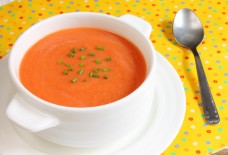By: Habeeb Salloum
Source: The Western Producer
My family of Syrian immigrants brought their love of freekeh with them to their homestead in southern Saskatchewan where it was a staple in the larder.
Every year, just before the wheat crop ripened, my mother would cut some of the wheat when it was turning yellow and the seeds were still soft and green. After being sun-dried, the wheat was set on fire.
The straw burned but not the seeds. The high moisture content remaining in the seeds prevented them from burning.
The roasted wheat was then rubbed by hand to remove any chaff left on the kernels, producing the annual supply of freekeh.
Today, no one has to go through this tiresome method, with machines doing the work of roasting.
It is factory-produced and available in many health food stores, Middle Eastern food outlets and in some of the major supermarkets and from wholesale companies like Cedar Phoenicia in Quebec.
“Our company decided to carry freekeh because of the great interest in North America about the Mediterranean diet and also because of the demand for it by the Arabic-speaking community in Montreal,” said Cedar’s salesperson Madam Rula.
There is no exact replica of this ancient health food that dates back to antiquity in Syrian history.
It is sold either in its whole form or cracked or crushed, the latter being the more popular version. Cracked freekeh is more in demand because it takes only 20 minutes to cook, while the whole grain freekeh takes about 50 minutes.
About 2 1/2 cups of water or broth to one cup of freekeh is required for cooking.
It can be used in dishes such as salads, stuffing, soups, stews, stir fries or risotto.
In the Middle East, every country has its favourite freekeh dish. In Syria, it’s fareekat lahma (lamb and freekeh) and in Tunisia, Shurbat fareek bil mukh (freekeh and bone marrow soup).
In Egypt, it’s hamaam bil-fareek (pigeon stuffed with freekeh) and in Palestine, it’s shurba al-fareek (soup with freekeh and chicken)
Many home cooks in Canada prefer it to rice or burghul.
“It’s the best staple because of its nutty smoky flavour. The taste sticks with you,” said Dr. Amal Asadi, a dentist originally from Jordan.
“Freekeh has a good crunch to it, not like rice and burghul that become very soft after cooking,” said Juhayna Younes, a homemaker of Lebanese origin.
“I’ve never tasted anything like this. I thought that quinoa was the super grain but now I’m moving on to freekeh,” said Linda Schwartz, a homemaker and avid gardener, after sampling a freekeh salad.
Samira Helbaoui, originally form Damascus, Syria, said freekeh is as common on the Damascene table as salt and pepper.
“I don’t know why (I like it), other than it’s healthy and when you cook it, it gives off a wonderful aroma. You feel that you are about to have a real home-cooked meal,” she said.
It was sometime in 2300 BC in ancient Syria that freekeh, often spelled frikeh or farik, came to be.
According to Syrian folklore, one of the villages in the northern part of the country received word of an impending enemy attack.
Knowing that the raid would result in the loss of their wheat crops, green at the time, and ultimate starvation for the people, the villagers picked the early green heads of the wheat and stored them.
The enemy arrived and devastated the area with fires. To save what they could of their wheat, the villagers rubbed away the burned chaff, and found roasted wheat kernels inside, yet still green in colour, reports author Bonnie Matthews in The Freekeh Cookbook.
Some believe this might be the fresh grain that is coarsely ground and roasted on a fire mentioned in Leviticus 2:14. In a 13th century Arabic cookbook from Baghdad, the author provides a recipe for farikeeya made from freekeh, according to A Baghdad Cookery Book.
Scientific studies have discovered what the people of the Middle East have long known. Grain, when harvested prior to ripeness, retains more of its proteins, vitamins and minerals.
Freekeh contains iron, selenium, potassium, magnesium, and zinc and is considered a super food. It has a high fibre content and four times as much insoluble fibre as grains such as quinoa and farro. This large amount of fibre improves bowel health and it is so filling that it is credited with helping to control weight.
Freekeh is a largely fat-free cereal food and compares well to other grains sold in health stores, with four grams of fibre and eight percent protein in each quarter cup of the raw product. It also has a low glycemic index, so it can help control diabetes.








